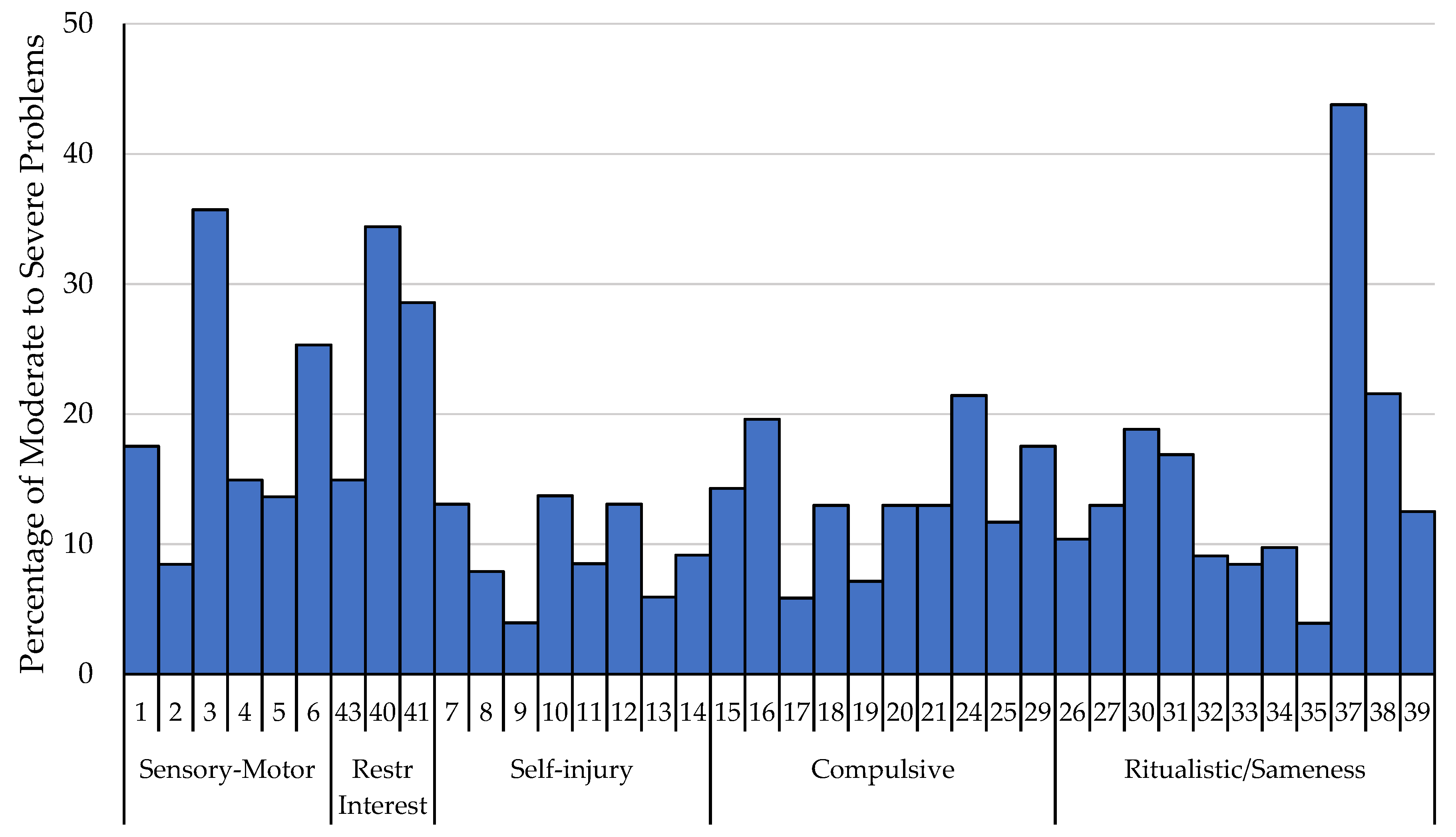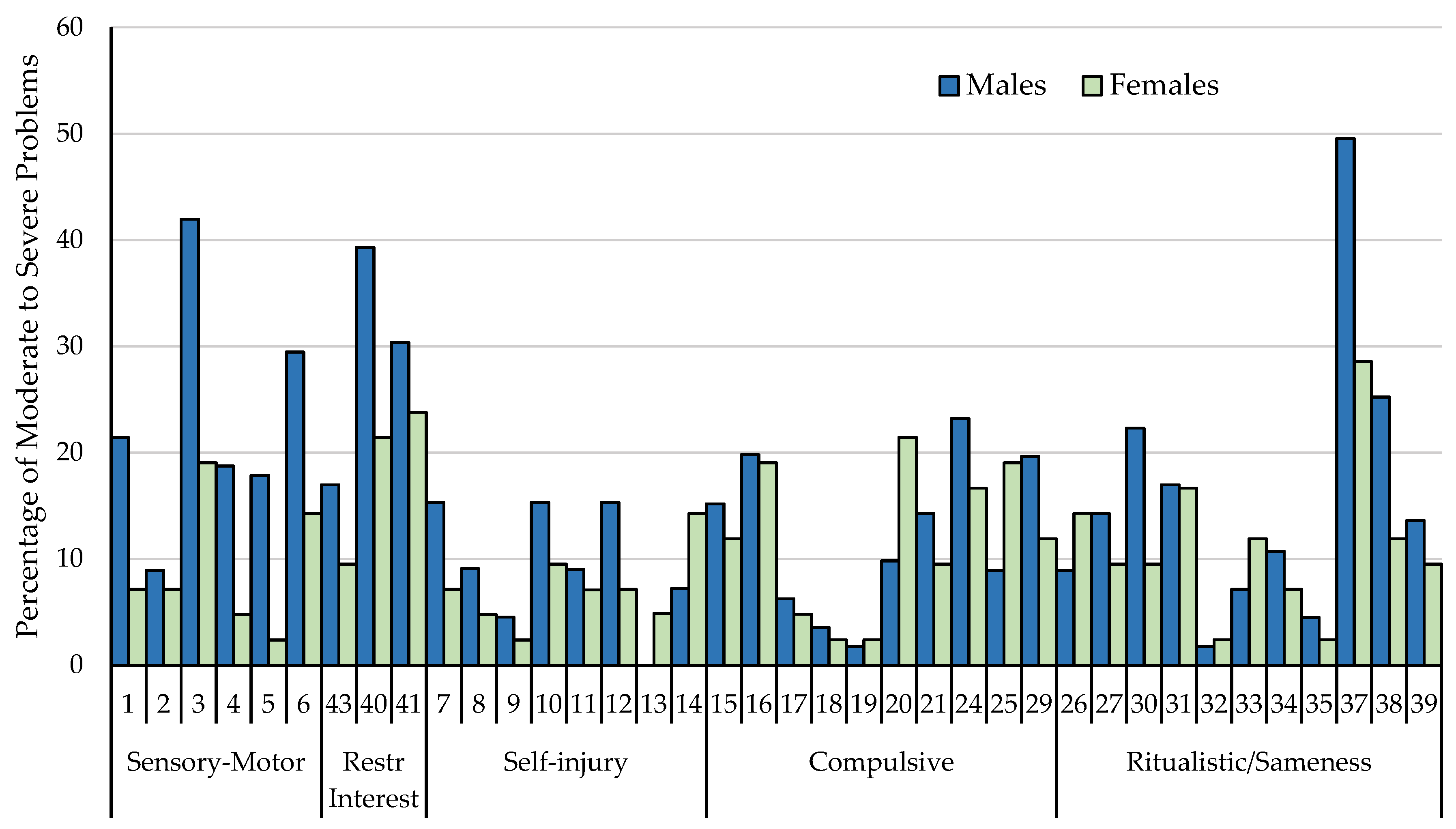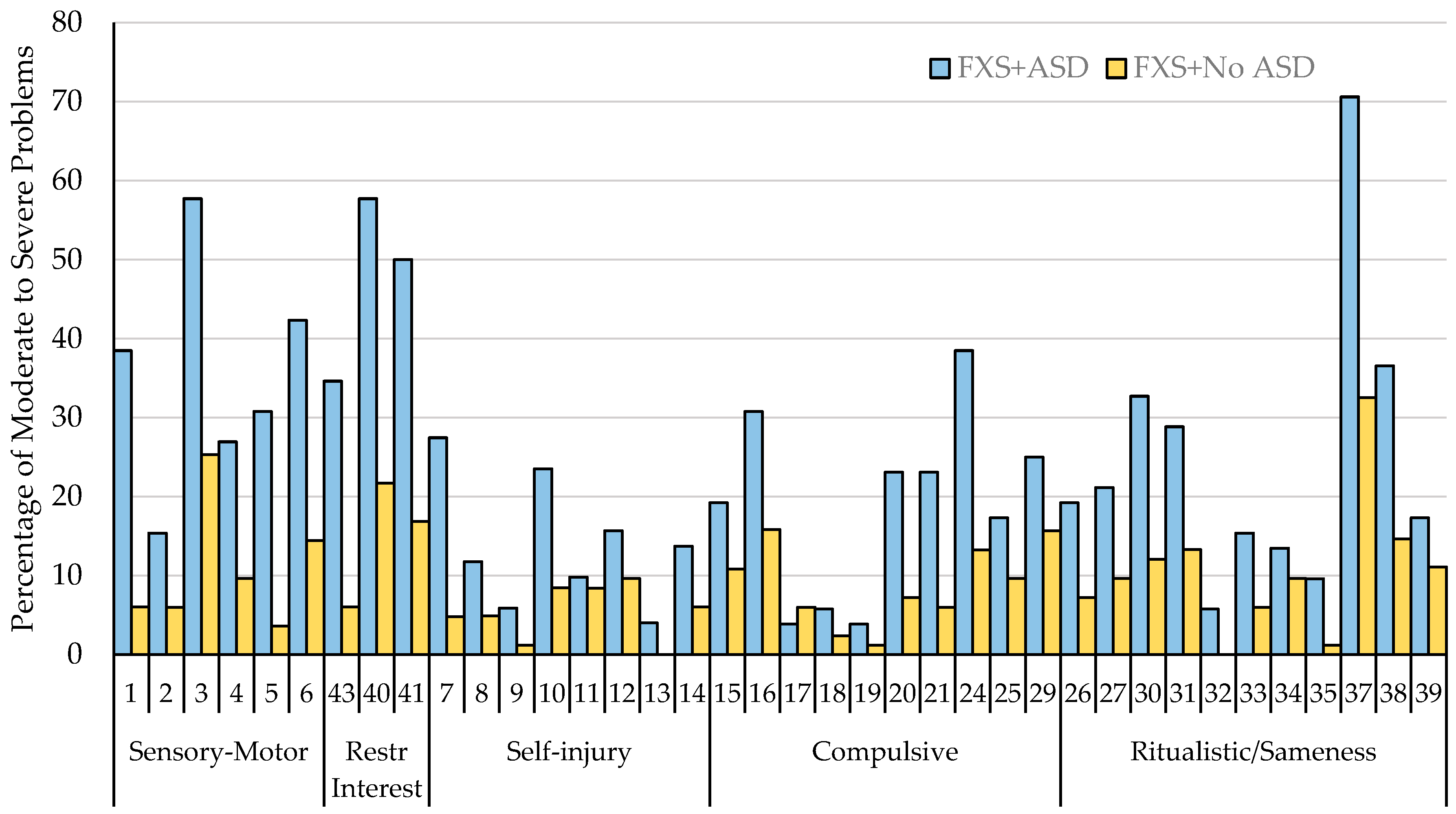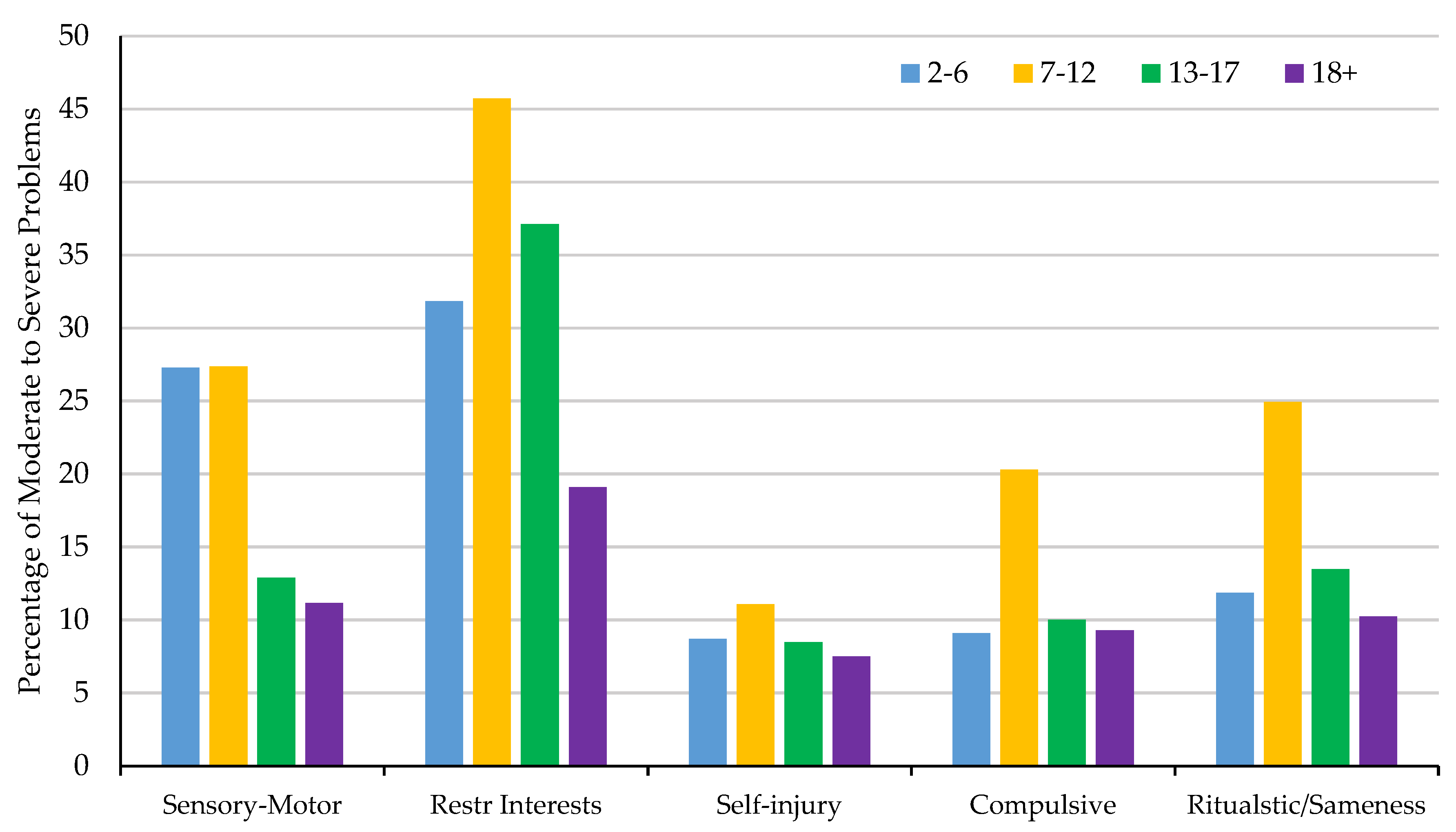Delineating Repetitive Behavior Profiles across the Lifespan in Fragile X Syndrome
Abstract
1. Introduction
1.1. Fragile X Syndrome
1.2. Restricted Repetitive Behaviors
Restricted Repetitive Behaviors in FXS
1.3. The Present Study
2. Materials and Methods
2.1. Participants
2.2. Measures
2.3. Procedures
2.4. Data Analysis
3. Results
3.1. Correlations with Clinical Measures
3.2. Item Level Differences
3.2.1. Gender
3.2.2. ASD Diagnosis
3.3. Subscale Level Differences
3.3.1. Age
3.3.2. Gender
3.3.3. ASD Diagnosis
3.4. Impact of Gender and ASD Diagnosis on RBS-R Scores
3.4.1. Sensory-Motor
3.4.2. Restricted Interests
3.4.3. Self-Injury
3.4.4. Compulsive
3.4.5. Ritualistic/Sameness
4. Discussion
4.1. Summary of Findings
4.2. Limitations
5. Conclusions and Future Directions
Author Contributions
Funding
Acknowledgments
Conflicts of Interest
References
- American Psychiatric Association. Diagnostic and Statistical Manual of Mental Disorders, 5th ed.; American Psychiatric Association: Washington, DC, USA, 2013. [Google Scholar]
- Oakes, A.; Thurman, A.J.; Mcduffie, A.; Bullard, L.M.; Hagerman, R.J.; Abbeduto, L. Characterising repetitive behaviours in young boys with fragile X syndrome. J. Intellect. Disabil. Res. 2016, 60, 54–67. [Google Scholar] [CrossRef] [PubMed]
- Wolff, J.J.; Bodfish, J.W.; Hazlett, H.C.; Lightbody, A.A.; Reiss, A.L.; Piven, J. Evidence of a distinct behavioral phenotype in young boys with fragile x syndrome and autism. J. Am. Acad. Child. Adolesc. Psychiatry 2012, 51, 1324–1332. [Google Scholar] [CrossRef]
- Moskowitz, L.J.; Will, E.A.; Conner, J.B.; Black, J.; Roberts, J.E. Restricted and Repetitive Behaviors in Males and Females with Fragile X Syndrome: Developmental Trajectories in Toddlers Through Young Adults Developmental Trajectories of Restricted and Repetitive Behaviors in Males and Females with Fragile X Syndrome. J. Autism Dev. Disord. 2020. [Google Scholar] [CrossRef]
- Hagerman, R.J.; Hagerman, P.J. Fragile X Syndrome: Diagnosis, Treatment, and Research; Taylor & Francis: Boca Raton, FL, USA, 2002. [Google Scholar]
- Bailey, D.B.; Raspa, M.; Olmsted, M.; Holiday, D.B. Co-occurring conditions associated with FMR1 gene variations: Findings from a national parent survey. Am. J. Med. Genet. Part A 2008, 146, 2060–2069. [Google Scholar] [CrossRef] [PubMed]
- Cordeiro, L.; Ballinger, E.; Hagerman, R.; Hessl, D. Clinical assessment of DSM-IV anxiety disorders in fragile X syndrome: Prevalence and characterization. J. Neurodev. Disord. 2011, 3, 57–67. [Google Scholar] [CrossRef] [PubMed]
- Ciaccio, C.; Fontana, L.; Milani, D.; Tabano, S.; Miozzo, M.; Esposito, S. Fragile X syndrome: A review of clinical and molecular diagnoses. Ital. J. Pediatr. 2017, 43. [Google Scholar] [CrossRef] [PubMed]
- Tassone, F.; Iong, K.P.; Tong, T.H.; Lo, J.; Gane, L.W.; Berry-Kravis, E.; Nguyen, D.; Mu, L.Y.; Laffin, J.; Bailey, D.B.; et al. FMR1 CGG allele size and prevalence ascertained through newborn screening in the United States. Genome Med. 2012, 4, 100. [Google Scholar] [CrossRef] [PubMed]
- Hunter, J.; Rivero-Arias, O.; Angelov, A.; Kim, E.; Fotheringham, I.; Leal, J. Epidemiology of fragile X syndrome: A systematic review and meta-analysis. Am. J. Med. Genet. Part A 2014, 164, 1648–1658. [Google Scholar] [CrossRef] [PubMed]
- Schaefer, G.B.; Mendelsohn, N.J. Clinical genetics evaluation in identifying the etiology of autism spectrum disorders: 2013 guideline revisions. Genet. Med. 2013, 15, 399–407. [Google Scholar] [CrossRef]
- Kaufmann, W.E.; Kidd, S.A.; Andrews, H.F.; Budimirovic, D.B.; Esler, A.; Haas-Givler, B.; Stackhouse, T.; Riley, C.; Peacock, G.; Sherman, S.L.; et al. Autism spectrum disorder in fragile X syndrome: Cooccurring conditions and current treatment. Pediatrics 2017, 139, S194–S206. [Google Scholar] [CrossRef]
- Klusek, J.; Martin, G.E.; Losh, M. Consistency between research and clinical diagnoses of autism among boys and girls with fragile X syndrome. J. Intellect. Disabil. Res. 2014, 58, 940–952. [Google Scholar] [CrossRef]
- Talisa, V.B.; Boyle, L.; Crafa, D.; Kaufmann, W.E. Autism and anxiety in males with fragile X syndrome: An exploratory analysis of neurobehavioral profiles from a parent survey. Am. J. Med. Genet. Part A 2014, 164, 1198–1203. [Google Scholar] [CrossRef]
- Abbeduto, L.; McDuffie, A.; Thurman, A.J. The fragile x syndrome-autism comorbidity: What do we really know? Front. Genet. 2014, 5. [Google Scholar] [CrossRef] [PubMed]
- Hall, S.S.; Lightbody, A.A.; Hirt, M.; Rezvani, A.; Reiss, A.L. Autism in fragile X syndrome: A category mistake? J. Am. Acad. Child. Adolesc. Psychiatry 2010, 49, 921–933. [Google Scholar] [CrossRef]
- Lee, M.; Martin, G.E.; Berry-Kravis, E.; Losh, M. A developmental, longitudinal investigation of autism phenotypic profiles in fragile X syndrome. J. Neurodev. Disord. 2016, 8, 1–10. [Google Scholar] [CrossRef]
- Richards, C.; Jones, C.; Groves, L.; Moss, J.; Oliver, C. Prevalence of autism spectrum disorder phenomenology in genetic disorders: A systematic review and meta-analysis. Lancet Psychiatry 2015, 2, 909–916. [Google Scholar] [CrossRef]
- Evans, D.W.; Leckman, J.F.; Carter, A.; Reznick, J.S.; Henshaw, D.; King, R.A.; Pauls, D. Ritual, Habit, and Perfectionism: The Prevalence and Development of Compulsive-like Behavior in Normal Young Children. Child. Dev. 1997, 68, 58–68. [Google Scholar] [CrossRef] [PubMed]
- Thelen, E. Rhythmical stereotypies in normal human infants. Anim. Behav. 1979, 27, 699–715. [Google Scholar] [CrossRef]
- DeLoache, J.S.; Simcock, G.; Macari, S. Planes, Trains, Automobiles-and Tea Sets: Extremely Intense Interests in Very Young Children. Dev. Psychol. 2007, 43, 1579–1586. [Google Scholar] [CrossRef] [PubMed]
- Harrop, C.; McConachie, H.; Emsley, R.; Leadbitter, K.; Green, J. Restricted and repetitive behaviors in autism spectrum disorders and typical development: Cross-sectional and longitudinal comparisons. J. Autism Dev. Disord. 2014, 44, 1207–1219. [Google Scholar] [CrossRef]
- Troyb, E.; Knoch, K.; Herlihy, L.; Stevens, M.C.; Chen, C.M.; Barton, M.; Treadwell, K.; Fein, D. Restricted and Repetitive Behaviors as Predictors of Outcome in Autism Spectrum Disorders. J. Autism Dev. Disord. 2016, 46, 1282–1296. [Google Scholar] [CrossRef] [PubMed]
- Bodfish, J.W.; Symons, F.J.; Parker, D.E.; Lewis, M.H. Varieties of repetitive behavior in autism: Comparisons to mental retardation. J. Autism Dev. Disord. 2000, 30, 237–243. [Google Scholar] [CrossRef] [PubMed]
- Martin, G.E.; Roberts, J.E.; Helm-Estabrooks, N.; Sideris, J.; Vanderbilt, J.; Moskowitz, L. Perseveration in the connected speech of boys with fragile X syndrome with and without autism spectrum disorder. Am. J. Intellect. Dev. Disabil. 2012, 117, 384–399. [Google Scholar] [CrossRef] [PubMed][Green Version]
- Hall, S.S.; Lightbody, A.A.; Reiss, A.L. Compulsive, self-injurious, and autistic behavior in children and adolescents with fragile X syndrome. Am. J. Ment. Retard. 2008, 113. [Google Scholar] [CrossRef]
- Moss, J.; Oliver, C.; Arron, K.; Burbidge, C.; Berg, K. The prevalence and phenomenology of repetitive behavior in genetic syndromes. J. Autism Dev. Disord. 2009, 39, 572–588. [Google Scholar] [CrossRef] [PubMed]
- Lee, A.W.; Ventola, P.; Budimirovic, D.; Berry-Kravis, E.; Visootsak, J. Clinical development of targeted fragile X syndrome treatments: An industry perspective. Brain Sci. 2018, 8, 214. [Google Scholar] [CrossRef]
- McDuffie, A.; Oakes, A.; Machalicek, W.; Ma, M.; Bullard, L.; Nelson, S.; Abbeduto, L. Early language intervention using distance video-teleconferencing: A pilot study of young boys with fragile X syndrome and their mothers. Am. J. Speech Lang. Pathol. 2016, 25, 46–66. [Google Scholar] [CrossRef]
- Crawford, H.; Moss, J.; Stinton, C.; Singla, G.; Oliver, C. Overactivity, impulsivity and repetitive behaviour in males with fragile X syndrome: Contrasting developmental trajectories in those with and without elevated autism symptoms. J. Intellect. Disabil. Res. 2018, 62, 672–683. [Google Scholar] [CrossRef]
- McDuffie, A.; Abbeduto, L.; Lewis, P.; Kover, S.; Kim, J.S.; Weber, A.; Brown, W.T. Autism spectrum disorder in children and adolescents with fragile X syndrome: Within-syndrome differences and age-related changes. Am. J. Intellect. Dev. Disabil. 2010, 115, 307–326. [Google Scholar] [CrossRef]
- Sherman, S.L.; Kidd, S.A.; Riley, C.; Berry-Kravis, E.; Andrews, H.F.; Miller, R.M.; Lincoln, S.; Swanson, M.; Kaufmann, W.E.; Brown, W.T. Forward: A registry and longitudinal clinical database to study fragile X syndrome. Pediatrics 2017, 139, S183–S193. [Google Scholar] [CrossRef]
- Roid, G.H. Stanford-Binet Intelligence Scales, 5th ed.; Riverside Publishing: Itasca, IL, USA, 2003. [Google Scholar]
- Sansone, S.M.; Schneider, A.; Bickel, E.; Berry-Kravis, E.; Prescott, C.; Hessl, D. Improving IQ measurement in intellectual disabilities using true deviation from population norms. J. Neurodev. Disord. 2014, 6, 16. [Google Scholar] [CrossRef] [PubMed]
- Aman, M.G.; Singh, N.N.; Stewart, A.W.; Field, C.J. The aberrant behavior checklist: A behavior rating scale for the assessment of treatment effects. Am. J. Ment. Defic. 1985, 89, 485–491. [Google Scholar] [PubMed]
- Rutter, M.; Bailey, A.; Lord, C. Social Communication Questionnaire; Western Psychological Services: Los Angeles, CA, USA, 2003. [Google Scholar]
- Constantino, J.; Gruber, C. Social Responsiveness Scale, 2nd ed.; Western Psychological Services: Los Angeles, CA, USA, 2012. [Google Scholar]
- Sansone, S.M.; Widaman, K.F.; Hall, S.S.; Reiss, A.L.; Lightbody, A.; Kaufmann, W.E.; Berry-Kravis, E.; Lachiewicz, A.; Brown, E.C.; Hessl, D. Psychometric study of the aberrant behavior checklist in fragile X syndrome and implications for targeted treatment. J. Autism Dev. Disord. 2012, 42, 1377–1392. [Google Scholar] [CrossRef] [PubMed]
- Scahill, L.; Aman, M.G.; Lecavalier, L.; Halladay, A.K.; Bishop, S.L.; Bodfish, J.W.; Grondhuis, S.; Jones, N.; Horrigan, J.P.; Cook, E.H.; et al. Measuring repetitive behaviors as a treatment endpoint in youth with autism spectrum disorder. Autism 2015, 19, 38–52. [Google Scholar] [CrossRef] [PubMed]
- Mirenda, P.; Smith, I.M.; Vaillancourt, T.; Georgiades, S.; Duku, E.; Szatmari, P.; Bryson, S.; Fombonne, E.; Roberts, W.; Volden, J.; et al. Validating the repetitive behavior scale-revised in young children with autism spectrum disorder. J. Autism Dev. Disord. 2010, 40, 1521–1530. [Google Scholar] [CrossRef]
- Lam, K.S.L.; Aman, M.G. The repetitive behavior scale-revised: Independent validation in individuals with autism spectrum disorders. J. Autism Dev. Disord. 2007, 37, 855–866. [Google Scholar] [CrossRef]
- Bishop, S.L.; Hus, V.; Duncan, A.; Huerta, M.; Gotham, K.; Pickles, A.; Kreiger, A.; Buja, A.; Lund, S.; Lord, C. Subcategories of restricted and repetitive behaviors in children with autism spectrum disorders. J. Autism Dev. Disord. 2013, 43, 1287–1297. [Google Scholar] [CrossRef]
- Hooker, J.L.; Dow, D.; Morgan, L.; Schatschneider, C.; Wetherby, A.M. Psychometric analysis of the repetitive behavior scale-revised using confirmatory factor analysis in children with autism. Autism Res. 2019, 12, 1399–1410. [Google Scholar] [CrossRef]
- Berry-Kravis, E.; Hessl, D.; Abbeduto, L.; Reiss, A.L.; Beckel-Mitchener, A.; Urv, T.K.; Measures, O.; Groups, W.; Aman, M.; Clapp, K.; et al. Outcome Measures for Clinical Trials in Fragile X Syndrome. J. Dev. Behav. Pediatr. 2013, 34, 508–522. [Google Scholar] [CrossRef]
- Yatawara, C.J.; Einfeld, S.L.; Hickie, I.B.; Davenport, T.A.; Guastella, A.J. The effect of oxytocin nasal spray on social interaction deficits observed in young children with autism: A randomized clinical crossover trial. Mol. Psychiatry 2016, 21, 1225–1231. [Google Scholar] [CrossRef]
- Bernaerts, S.; Boets, B.; Bosmans, G.; Steyaert, J.; Alaerts, K. Behavioral effects of multiple-dose oxytocin treatment in autism: A randomized, placebo-controlled trial with long-term follow-up. Mol. Autism 2020, 11, 1–14. [Google Scholar] [CrossRef] [PubMed]
- Hardan, A.Y.; Fung, L.K.; Libove, R.A.; Obukhanych, T.V.; Nair, S.; Herzenberg, L.A.; Frazier, T.W.; Tirouvanziam, R. A randomized controlled pilot trial of oral N-acetylcysteine in children with autism. Biol. Psychiatry 2012, 71, 956–961. [Google Scholar] [CrossRef] [PubMed]




| Total Sample | Males with FXS | Females with FXS | |||||||
|---|---|---|---|---|---|---|---|---|---|
| Variable | n | Mean | SD | n | Mean | SD | n | Mean | SD |
| Age (years) | 154 | 16.64 | 11.25 | 112 | 16.69 | 11.68 | 42 | 16.51 | 10.55 |
| Verbal IQ | 122 | 54.22 | 16.36 | 85 | 48.89 | 11.34 | 38 | 66.00 | 19.51 |
| Nonverbal IQ | 122 | 52.42 | 15.53 | 85 | 47.79 | 12.55 | 38 | 63.05 | 16.64 |
| Deviation Verbal IQ | 119 | 52.02 | 24.34 | 83 | 44.48 | 21.31 | 36 | 69.43 | 22.07 |
| Deviation Nonverbal IQ | 119 | 50.42 | 22.86 | 83 | 43.35 | 20.59 | 36 | 66.72 | 19.41 |
| Adaptive Behavior Composite | 119 | 55.08 | 21.28 | 91 | 50.65 | 18.06 | 28 | 69.50 | 24.73 |
| SCQ | 136 | 13.24 | 6.95 | 98 | 14.35 | 6.37 | 38 | 10.37 | 7.64 |
| SRS-2 Total T-Score | 133 | 67.74 | 12.70 | 98 | 68.05 | 11.86 | 35 | 66.89 | 14.99 |
| ABC Irritability | 145 | 13.20 | 11.62 | 106 | 14.01 | 11.26 | 39 | 11.00 | 12.45 |
| ABC Lethargy | 145 | 5.51 | 5.40 | 106 | 5.33 | 4.96 | 39 | 6.00 | 6.509 |
| ABC Stereotypy | 145 | 4.75 | 4.58 | 106 | 5.16 | 4.59 | 39 | 3.64 | 4.44 |
| ABC Hyperactivity | 145 | 9.58 | 7.48 | 106 | 10.49 | 7.49 | 39 | 7.10 | 6.97 |
| ABC Social Avoidance | 145 | 2.73 | 3.40 | 106 | 2.41 | 3.10 | 39 | 3.62 | 4.03 |
| ABC Inappropriate Speech | 145 | 3.87 | 3.18 | 106 | 4.19 | 3.12 | 39 | 3.00 | 3.26 |
| Subscale | Age (N = 154) | Nonverbal IQ (N = 119) | Verbal IQ (N = 119) | Vineland ABC (N = 119) | ABC Social Avoidance (N = 145) | ABC Hyperactivity (N = 145) | ABC Inappropriate Speech (N = 145) | ABC Irritability (N = 145) | ABC Lethargy (N = 145) | ABC Stereotypy (N = 145) | SRS-2 RRB (N = 133) | SRS-2 Total (N = 133 | SCQ Total (N = 136) |
|---|---|---|---|---|---|---|---|---|---|---|---|---|---|
| Sensory-Motor | −0.274 * | −0.423 * | −0.447 * | −0.272 * | 0.140 | 0.538 * | 0.258 * | 0.486 * | 0.357 * | 0.746 * | 0.494 * | 0.514 * | 0.600 * |
| Restricted Interests | −0.154 | −0.372 * | −0.383 * | −0.231 * | 0.299 * | 0.390 * | 0.320 * | 0.454 * | 0.307 * | 0.440 * | 0.565 * | 0.567 * | 0.477 * |
| Self-injury | −0.053 | −0.274 * | −0.231 * | −0.199 * | 0.353 * | 0.302 * | 0.283 * | 0.465 * | 0.259 * | 0.263 * | 0.384 * | 0.429 * | 0.339 * |
| Compulsive | −0.045 | −0.151 | −0.196 * | −0.103 | 0.336 * | 0.360 * | 0.391 * | 0.457 * | 0.323 * | 0.254 * | 0.476 * | 0.454 * | 0.341 * |
| Ritualistic/Sameness | −0.056 | −0.328 * | −0.310 * | −0.287 * | 0.380 * | 0.497 * | 0.443 * | 0.580 * | 0.434 * | 0.398 * | 0.617 * | 0.565 * | 0.464 * |
| RBS-R Subscales by Bishop et al. (2013) | Item | Mean Score Total Sample (SD) (N = 154) | Mean Score Males (SD) (N = 112) | Mean Score Females (SD) (N = 42) | Mean Differences between Males and Females | Mean Score ASD Diagnosis (SD) (N = 52) | Mean Score No ASD Diagnosis (SD) (N = 83) | Mean Differences between ASD Diagnosis |
|---|---|---|---|---|---|---|---|---|
| Sensory-Motor | 1. Whole Body | 0.58 (0.91) | 0.68 (0.97) | 0.31 (0.68) | 0.009 *,† | 1.06 (1.13) | 0.30 (0.62) | 0.000 *,† |
| 2. Head | 0.32 (0.66) | 0.35 (0.69) | 0.26 (0.59) | 0.475 | 0.60 (0.85) | 0.20 (0.54) | 0.004 *,† | |
| 3. Hand/finger | 1.12 (1.03) | 1.29 (0.99) | 0.67 (1.00) | 0.001 * | 1.62 (1.05) | 0.89 (0.92) | 0.000 * | |
| 4. Locomotion | 0.54 (0.87) | 0.67 (0.92) | 0.19 (0.59) | 0.000 *,† | 0.88 (1.02) | 0.36 (0.73) | 0.002 *,† | |
| 5. Object usage | 0.58 (0.84) | 0.74 (0.90) | 0.17 (0.44) | 0.000 *,† | 0.96 (1.07) | 0.36 (0.55) | 0.000 *,† | |
| 6. Sensory | 0.89 (0.97) | 0.96 (0.99) | 0.69 (0.90) | 0.121 | 1.35 (1.15) | 0.64 (0.76) | 0.000 *,† | |
| 43. Fascination, preoccupation with movement | 0.57 (0.90) | 0.68 (0.94) | 0.29 (0.71) | 0.006 *,† | 1.10 (1.14) | 0.31 (0.62) | 0.000 *,† | |
| Restricted Interests | 40. Fascination, preoccupation with one subject or activity | 1.12 (1.00) | 1.24 (0.98) | 0.81 (0.99) | 0.016 * | 1.60 (1.03) | 0.86 (0.90) | 0.000 * |
| 41. Strongly attached to one specific object | 0.92 (1.10) | 0.97 (1.10) | 0.76 (1.08) | 0.285 | 1.46 (1.13) | 0.61 (0.96) | 0.000 *,† | |
| Self-injury | 7. Hits self with body part | 0.44 (0.77) | 0.50 (0.82) | 0.29 (0.60) | 0.072 † | 0.78 (0.90) | 0.25 (0.54) | 0.000 *,† |
| 8. Hits self against surface or object | 0.32 (0.70) | 0.36 (0.75) | 0.19 (0.51) | 0.105 † | 0.47 (0.76) | 0.21 (0.56) | 0.035 *,† | |
| 9. Hits self with object | 0.20 (0.54) | 0.23 (0.59) | 0.12 (0.40) | 0.193 † | 0.27 (0.56) | 0.11 (0.35) | 0.067 † | |
| 10. Bites self | 0.51 (0.86) | 0.57 (0.88) | 0.36 (0.79) | 0.177 | 0.78 (1.06) | 0.34 (0.67) | 0.009 *,† | |
| 11. Pulls hair or skin | 0.31 (0.68) | 0.32 (0.71) | 0.31 (0.60) | 0.963 | 0.37 (0.77) | 0.29 (0.62) | 0.492 | |
| 12. Rubs or scratches self | 0.45 (0.78) | 0.48 (0.82) | 0.38 (0.70) | 0.500 | 0.47 (0.86) | 0.42 (0.70) | 0.719 | |
| 13. Inserts finger or object | 0.07 (0.31) | 0.05 (0.21) | 0.15 (0.48) | 0.196 † | 0.14 (0.45) | 0.04 (0.19) | 0.067 † | |
| 14. Skin picking | 0.36 (0.74) | 0.30 (0.71) | 0.52 (0.80) | 0.113 † | 0.45 (0.88) | 0.27 (0.61) | 0.188 † | |
| Compulsive | 15. Arranging/ordering | 0.59 (0.83) | 0.61 (0.83) | 0.55 (0.83) | 0.693 | 0.69 (0.92) | 0.51 (0.72) | 0.218 † |
| 16. Completeness | 0.72 (0.94) | 0.76 (0.94) | 0.62 (0.96) | 0.422 | 1.06 (1.13) | 0.57 (0.82) | 0.009 *,† | |
| 17. Washing/cleaning | 0.30 (0.62) | 0.31 (0.64) | 0.26 (0.54) | 0.652 | 0.31 (0.54) | 0.28 (0.57) | 0.758 | |
| 18. Checking | 0.16 (0.45) | 0.18 (0.47) | 0.12 (0.40) | 0.466 | 0.23 (0.55) | 0.13 (0.41) | 0.267 † | |
| 19. Counting | 0.09 (0.35) | 0.09 (0.34) | 0.10 (0.37) | 0.925 | 0.12 (0.43) | 0.06 (0.29) | 0.370 | |
| 20. Hoarding/saving | 0.50 (0.85) | 0.43 (0.79) | 0.69 (0.98) | 0.124 † | 0.73 (1.10) | 0.34 (0.61) | 0.021 *,† | |
| 21. Repeating | 0.45 (0.80) | 0.47 (0.83) | 0.40 (0.73) | 0.638 | 0.67 (1.00) | 0.33 (0.59) | 0.026 *,† | |
| 24. Sleeping/Bedtime | 0.77 (0.99) | 0.82 (1.02) | 0.62 (0.88) | 0.855 | 1.12 (1.10) | 0.60 (0.90) | 0.006 *,† | |
| 25. Self-care (bathroom and dressing) | 0.47 (0.75) | 0.45 (0.71) | 0.52 (0.86) | 0.130 | 0.58 (0.87) | 0.45 (0.70) | 0.338 | |
| 29. Insists that things remain in the same place(s) | 0.61 (0.85) | 0.65 (0.88) | 0.50 (0.77) | 0.325 | 0.75 (0.97) | 0.55 (0.78) | 0.223 † | |
| Ritualistic/Sameness | 26. Travel/transportation | 0.46 (0.79) | 0.47 (0.81) | 0.43 (0.74) | 0.754 | 0.65 (0.97) | 0.39 (0.70) | 0.064 † |
| 27. Play/leisure | 0.51 (0.83) | 0.54 (0.87) | 0.43 (0.74 | 0.444 | 0.77 (1.00) | 0.39 (0.70) | 0.018 *,† | |
| 30. Objects to visiting new places | 0.70 (0.89) | 0.76 (0.92) | 0.55 (0.80) | 0.192 | 1.06 (1.07) | 0.54 (0.74) | 0.003 *,† | |
| 31. Becomes upset if interrupted in what he/she is doing | 0.77 (0.77) | 0.77 (0.77) | 0.79 (0.78) | 0.899 | 1.12 (0.83) | 0.64 (0.71) | 0.001 * | |
| 32. Insists on walking in a particular pattern | 0.11 (0.37) | 0.12 (0.37) | 0.10 (0.37) | 0.758 | 0.21 (0.54) | 0.06 (0.24) | 0.060 † | |
| 33. Insists on sitting in the same place | 0.43 (0.68) | 0.41 (0.65) | 0.48 (0.77) | 0.599 | 0.60 (0.85) | 0.37 (0.60) | 0.102 † | |
| 34. Dislikes changes in appearance or behavior of the other people around him/her | 0.46 (0.74) | 0.53 (0.78) | 0.29 (0.60) | 0.044 *,† | 0.58 (0.78) | 0.45 (0.77) | 0.338 | |
| 35. Insists on using a particular door | 0.17 (0.50) | 0.17 (0.52) | 0.17 (0.43) | 0.960 | 0.29 (0.64) | 0.13 (0.44) | 0.129 † | |
| 37. Resists changing activities; difficulty with transitions | 1.28 (0.96) | 1.41 (0.95) | 0.95 (0.91) | 0.008 * | 1.78 (0.81) | 1.05 (0.95) | 0.000 * | |
| 38. Insists on the same routine, household, school or work schedule everyday | 0.79 (0.93) | 0.87 (0.97) | 0.57 (0.77) | 0.072 | 1.12 (1.04) | 0.62 (0.83) | 0.005 *,† | |
| 39. Insists that specific things take place at specific times | 0.55 (0.83) | 0.56 (0.84) | 0.50 (0.80) | 0.673 | 0.71 (0.94) | 0.46 (0.76) | 0.087 |
| RBS-R Subscales by Bishop et al. (2013) | Mean Score Males (SD) (N = 112) | Mean Score Females (SD) (N = 42) | Mean Differences between Males and Females | Mean Score ASD Diagnosis (SD) (N = 52) | Mean Score No ASD Diagnosis (SD) (N = 83) | Mean Differences between ASD Diagnosis |
|---|---|---|---|---|---|---|
| Sensory Motor | 5.37 (4.30) | 2. 57 (3.64) | 0.000 *,† | 7.56 (4.82) | 3.07 (3.02) | 0.000 *,† |
| Restricted Interests | 2.21 (1.91) | 1.57 (1.89) | 0.643 | 3.06 (1.95) | 1.47 (1.66) | 0.000 * |
| Self-injury | 2.77 (3.42) | 2.31 (2.71) | 0.436 | 3.67 (3.25) | 1.92 (2.44) | 0.001 *,† |
| Compulsive | 4.76 (4.44) | 4.38 (5.25) | 0.655 | 6.25 (5.93) | 3.81 (3.76) | 0.010 *,† |
| Ritualistic/Sameness | 6.11 (5.17) | 4.81 (5.31) | 0.170 | 8.19 (5.86) | 4.69 (4.62) | 0.000 * |
© 2020 by the authors. Licensee MDPI, Basel, Switzerland. This article is an open access article distributed under the terms and conditions of the Creative Commons Attribution (CC BY) license (http://creativecommons.org/licenses/by/4.0/).
Share and Cite
Reisinger, D.L.; Shaffer, R.C.; Tartaglia, N.; Berry-Kravis, E.; Erickson, C.A. Delineating Repetitive Behavior Profiles across the Lifespan in Fragile X Syndrome. Brain Sci. 2020, 10, 239. https://doi.org/10.3390/brainsci10040239
Reisinger DL, Shaffer RC, Tartaglia N, Berry-Kravis E, Erickson CA. Delineating Repetitive Behavior Profiles across the Lifespan in Fragile X Syndrome. Brain Sciences. 2020; 10(4):239. https://doi.org/10.3390/brainsci10040239
Chicago/Turabian StyleReisinger, Debra L., Rebecca C. Shaffer, Nicole Tartaglia, Elizabeth Berry-Kravis, and Craig A. Erickson. 2020. "Delineating Repetitive Behavior Profiles across the Lifespan in Fragile X Syndrome" Brain Sciences 10, no. 4: 239. https://doi.org/10.3390/brainsci10040239
APA StyleReisinger, D. L., Shaffer, R. C., Tartaglia, N., Berry-Kravis, E., & Erickson, C. A. (2020). Delineating Repetitive Behavior Profiles across the Lifespan in Fragile X Syndrome. Brain Sciences, 10(4), 239. https://doi.org/10.3390/brainsci10040239





